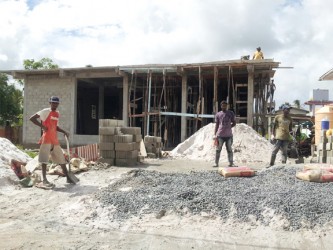Story and photos by Tifaine Rutherford and Shakisa Harvey
A long drive several miles behind the Mahaica market leads to this agricultural community that is located along the Mahaica River. Cane Grove is home to approximately 3000 residents and comprises smaller settlements, which include Manager Drive, Saywah, Coconut Dam, Virginia, Strathavon, Hopeland, Cane Grove Estate and Waterside Dam. It is also one of the oldest sugar estates in Guyana. One prominent figure who was a product of this community was John Carter, who was Guyana’s first ambassador to the United States of America.
The first thing that comes to mind is a village that has an abundance of cane. Residents here say however that cane was the main form of farming done years ago, but that now they are involved in rice farming and the cultivation of other crops. For the most part they sell their produce to vendors at the Mahaica or Mahaicony markets. In addition to the farmers, there are also a few public and private sector employees. Most of the inhabitants here are Indian, although other ethnic groups have made their home in Cane Grove as well. However, persons living here said that although this is so, there is no racism in the community. “Everyone here does live as one. We all live like brother and sister… [African or Indian] we all live together,” a resident said.

chat under a shed
There are several small shops to cater to the needs of the residents, including several liquor establishments, and there is also a private and public primary school, a post office, health centre, police station and the office of the Neighbourhood Democratic Council. A mandir serves the many Hindus in the community, and a mosque and Christian churches can be seen as well. Transportation in the village is available from the many hire cars that operate there, with fares ranging from $100 per person and $500 after six. Most of the residents said that there is no crime in the area. “This is one village that I can sleep with my door open. We don’t have no thief in here,” a resident said.
Decades ago there was a conservancy breach, and the entire village was under water, with large fields of crops destroyed. Shortly after, the sugar estate was closed, residents told Sunday Stabroek. “In 1964, there was a big flood and the whole village was under water. All of them crops were destroyed,” Collin Abrams said. A rice farmer for the past 42 years, he said that the area was a cane harvesting one and that it had suddenly turned to rice farming. He said that he plants about two crops a year and this is supplied to various markets country wide. The floods were a devastating time for the village, he said, as the sugar estate was in a dire state, both financially and physically.
In 2002 there was another conservancy breach which flooded the village and the fields, that occurred while work was being undertaken on the dam.
Several residents raised issues about the state of the trenches in the area and said that the present NDC was not doing anything about it.
Long ago, there was no electricity or a proper road in Cane Grove, but today the residents enjoy the basic necessities of life and live a simple lifestyle. Most of the men go to work in the rice fields, while the majority of the women stay home and look after their homes and children.
There is a community centre, but residents here say that they would like the government to intervene to provide a better sporting facility to avoid youths becoming addicted to alcohol. One major concern in the area, a resident who preferred to be unnamed said, is the problem with child labour. “A lot of young children does be working in the rice fields. This community has many underage workers. Human Services need to look into it,” he said.

The lack of bridges in the rice fields is also causing hardship for the rice farmers in the community. Kurt Marshall who is involved in cash crop farming said that there is a water users association that is supposed to be in charge of cleaning the trenches, but they are not doing anything proper. “The minister paying them a certain amount of money when the month come, and they are collecting the money and not cleaning the trench. The NDC and all get contracts to do the trenches and right now all silt up. I can’t even reap anything now because everything flood out right now,” the distressed farmer said.

What was once a small farming community has developed into a large agricultural village that residents say they wouldn’t trade for the world. “This is a blessed village. We have everything we could want in Cane Grove,” one said.

heading home from
running an errand

being constructed
in the village




